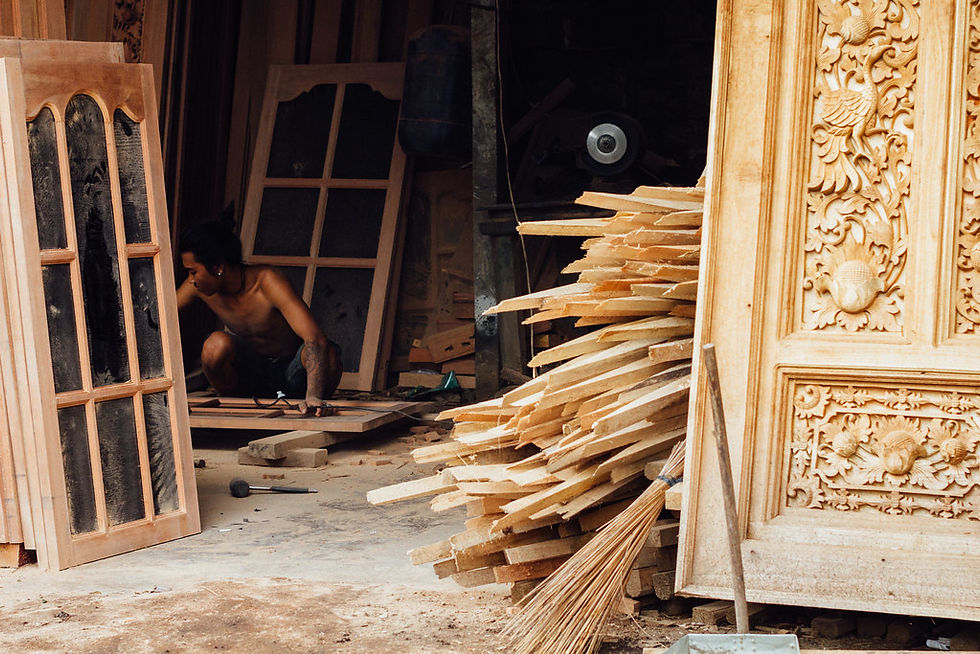Balinese Festivals and Their Impact on Local Craft Traditions
- ArtcomDesign

- May 19, 2024
- 3 min read

Bali, often referred to as the "Island of the Gods," is renowned for its vibrant culture and deep-rooted traditions. One of the most captivating aspects of Balinese culture is its festivals, which are not only colorful and joyous but also deeply spiritual. These festivals are a testament to the island's rich heritage and play a crucial role in inspiring and sustaining local craft traditions. In this blog post, we'll explore some of Bali's most significant festivals and how they influence and feature the island's exquisite craftsmanship.
Galungan and Kuningan: Celebrating the Victory of Good Over Evil
Galungan is one of the most important festivals in Bali, celebrating the triumph of dharma (good) over adharma (evil). It marks the time when ancestral spirits visit the earth, and Balinese Hindus express their gratitude through elaborate offerings and prayers. The festival lasts for ten days, culminating in Kuningan, when the spirits return to the heavens.
Craft Traditions:

- Penjor Making: One of the most striking symbols of Galungan is the penjor, a tall, curved bamboo pole decorated with coconut leaves, rice, fruits, and flowers. Creating a penjor is an art form in itself, requiring skill and creativity. Each village competes to make the most beautiful penjor, showcasing their craftsmanship.

- Offerings (Banten): Intricate offerings made from woven palm leaves, flowers, and food are a central part of the celebrations. Crafting these offerings is a meticulous process, passed down through generations, and a vital aspect of Balinese culture.
Nyepi: The Day of Silence
Nyepi, the Balinese New Year, is a unique festival that stands out due to its observance of complete silence. The day before Nyepi, known as Tawur Kesanga, is marked by vibrant parades featuring ogoh-ogoh, large, demonic statues made of bamboo and paper.
Craft Traditions:

- Ogoh-Ogoh Making: The creation of ogoh-ogoh is a community effort involving intricate craftsmanship. These statues are not only impressive in size but also in detail. Each village creates its own ogoh-ogoh, reflecting local myths and legends. The process of making these statues is a fascinating blend of traditional techniques and modern creativity.

- Traditional Masks and Costumes: For the Melasti purification ceremony preceding Nyepi, villagers wear traditional masks and costumes. These are handcrafted by local artisans, showcasing their expertise in mask-making and textile arts.
Saraswati Day: Honoring the Goddess of Knowledge
Saraswati Day is dedicated to Dewi Saraswati, the goddess of knowledge, music, and arts. On this day, Balinese Hindus honor books and sacred texts by placing them in temples and decorating them with offerings.
Craft Traditions:

- Book Covers and Temple Decorations: Artisans create beautifully adorned book covers and temple decorations using gold leaf, intricate carvings, and vibrant textiles. These decorations reflect the reverence for knowledge and the importance of preserving sacred texts.
- Handmade Offerings: Similar to other festivals, handmade offerings are an integral part of Saraswati Day. The craftsmanship involved in making these offerings highlights the Balinese commitment to tradition and artistic expression.
Odalan: Temple Anniversary Celebrations
Odalan is the anniversary celebration of a temple, occurring every 210 days. Each temple in Bali has its own odalan, making it a frequent and significant event in the Balinese calendar.
Craft Traditions:

- Temple Decorations: During odalan, temples are adorned with intricate decorations made from palm leaves, flowers, and bamboo. These decorations are crafted with great care and creativity, transforming the temple into a visual masterpiece.

- Traditional Dance Costumes: Traditional dances performed during odalan require elaborate costumes and accessories. These costumes are handmade by skilled artisans, reflecting the rich cultural heritage and artistic flair of the Balinese people.
The Enduring Legacy of Balinese Craftsmanship
Balinese festivals are more than just cultural celebrations; they are a vital source of inspiration for local artisans. The intricate crafts created for these festivals reflect the island's rich heritage and deep spiritual connection. By participating in these festivals, Balinese craftsmen and women not only preserve their traditions but also pass them on to future generations, ensuring that the island's unique artistic legacy endures.
As you explore the vibrant world of Balinese festivals, you'll gain a deeper appreciation for the intricate craftsmanship that defines this enchanting island. Whether it's the majestic penjor of Galungan, the fearsome ogoh-ogoh of Nyepi, or the ornate temple decorations of odalan, each festival offers a glimpse into the heart and soul of Bali's artistic traditions.


Comments